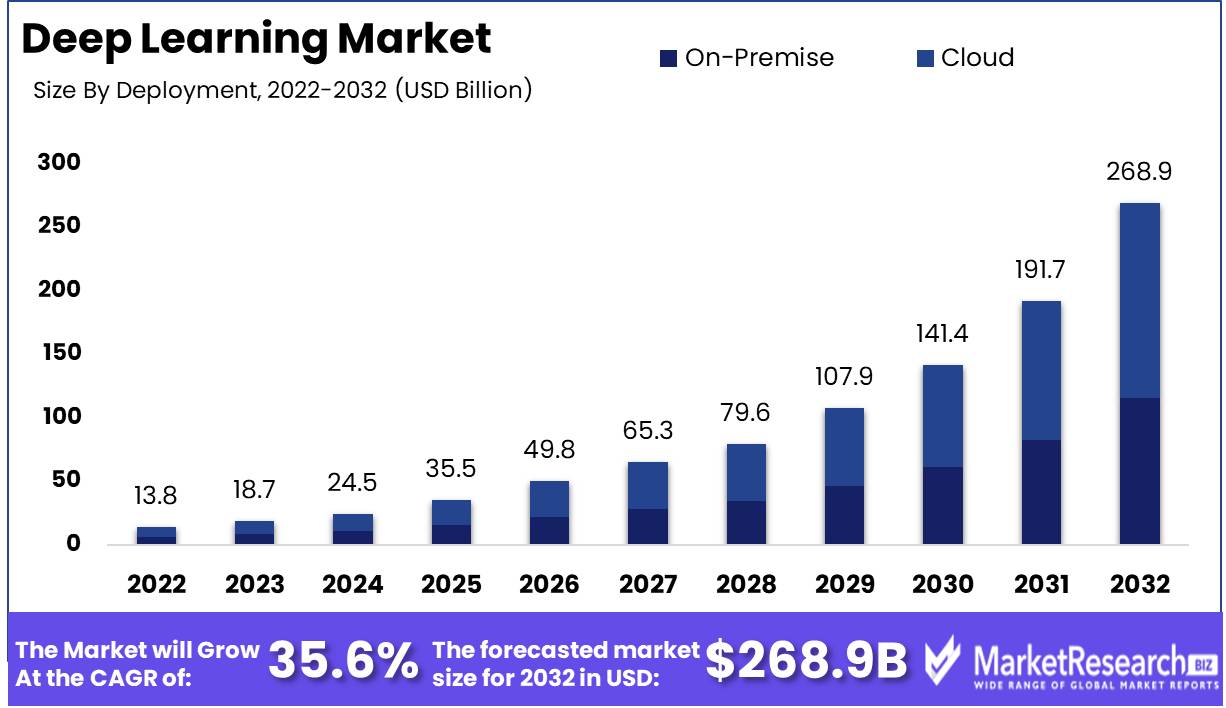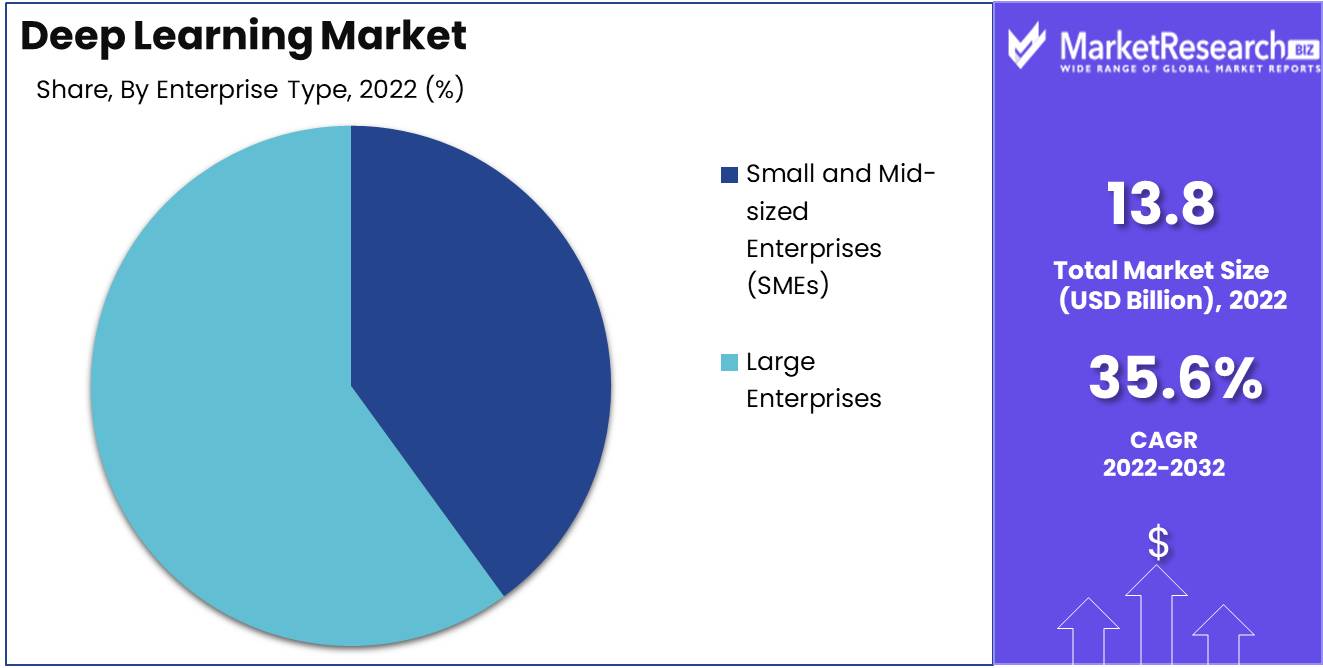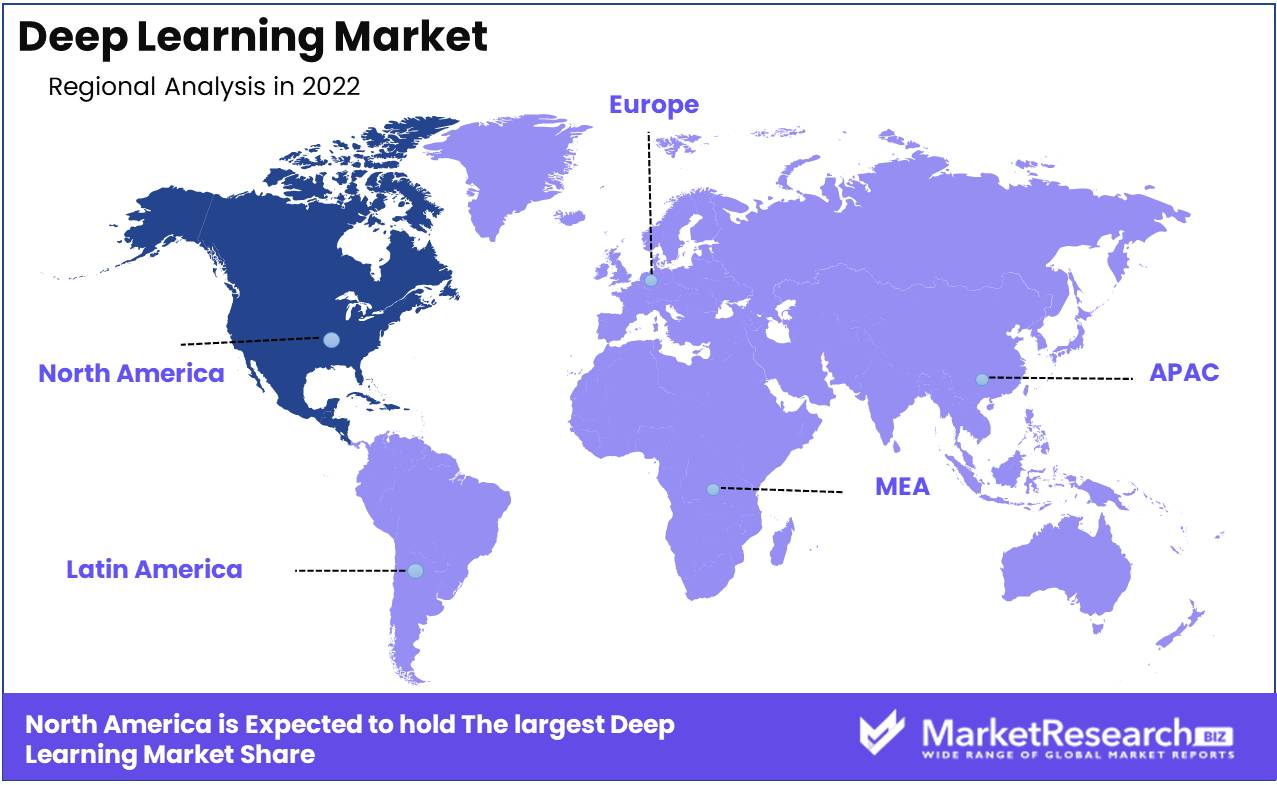
Deep Learning Market By Enterprise Type (Small and Mid-sized Enterprises (SMEs), Large Enterprises), By Deployment (Cloud, On-premise), By End-use Industry (Healthcare, Retail, IT and Telecommunication, Banking, and Others), By Region And Companies - Industry Segment Outlook, Market Assessment, Competition Scenario, Trends, And Forecast 2023-2032
-
21159
-
May 2023
-
160
-
-
This report was compiled by Vishwa Gaul Vishwa is an experienced market research and consulting professional with over 8 years of expertise in the ICT industry, contributing to over 700 reports across telecommunications, software, hardware, and digital solutions. Correspondence Team Lead- ICT Linkedin | Detailed Market research Methodology Our methodology involves a mix of primary research, including interviews with leading mental health experts, and secondary research from reputable medical journals and databases. View Detailed Methodology Page
-
Quick Navigation
Report Overview
Deep Learning Market size is expected to be worth around USD 268.9 Bn by 2032 from USD 13.8 Bn in 2022, growing at a CAGR of 35.6% during the forecast period from 2023 to 2032.
Deep learning Market is a subset of artificial intelligence (AI) that employs neural networks to acquire knowledge from massive quantities of data. The objective is to develop machines that can learn, reason, and make decisions like humans. The significance of deep learning rests in its capacity to efficiently process vast quantities of complex data and provide precise insights in a short amount of time. This capability is invaluable to numerous industries where data is the driving force behind decisions.

There are numerous benefits of deep learning, including increased precision, quicker processing rates, and less need for human intervention. Deep learning is ideally suited for use in industries where data processing is crucial and time is of the essence due to these features.
Utilizing convolutional neural networks (CNNs) is one of the most significant advances in deep learning. CNNs have revolutionized image recognition and computer vision by allowing computers to identify objects in images with human-like precision. The use of recurrent neural networks (RNNs) for natural language processing (NLP) is another significant innovation. These networks are capable of analyzing vast quantities of linguistic data and producing responses that are contextually appropriate.
Numerous industries invest in deep learning to enhance their processes and obtain a competitive advantage. Healthcare, automotive, retail, finance, and manufacturing are among these industries. The growth potential of deep learning has made it an attractive investment for businesses seeking to transform their operations and create new growth opportunities.
As with any potent technology, there are ethical concerns regarding deep learning. The potential for bias in deep learning models is one of the most significant concerns. This prejudice can lead to discrimination and suboptimal decision-making. To resolve these issues, there is a focus on transparency, explainability, and accountability in the development and deployment of deep learning. It is crucial to ensure that deep learning models are accurate, impartial, and equitable.
Driving factors
Adoption across numerous industries
Deep learning has broad applications in numerous industries, including healthcare, finance, retail, and e-commerce, among others. In healthcare, for instance, deep learning algorithms can assist physicians in diagnosing patients, predicting the severity of their illness, and recommending treatments. In finance, deep learning algorithms can assist businesses with market trend forecasting, fraud detection, and portfolio optimization.
By providing personalized product suggestions and optimizing store layouts, retailers are utilizing deep learning to enhance the consumer experience. To enhance search results, product recommendations, and the purchasing experience in the e-commerce industry, deep learning algorithms are used.
The widespread adoption of deep learning in these industries is primarily attributable to its ability to solve complex problems and make data-driven decisions, enabling businesses to gain insights and generate actionable recommendations that improve business processes.
Technological progress and data availability
Hardware advancements, such as graphics processing units (GPUs) and tensor processing units (TPUs), have contributed substantially to the development and acceleration of deep learning algorithms. These developments have enabled the processing of vast quantities of data, which is essential for training deep learning models and attaining high precision.
In addition, the increased availability of large and diverse datasets has been an essential factor in the development of deep learning. There are now an abundance of open-source and proprietary datasets that can be used to train deep learning algorithms as a result of the proliferation of the internet and advances in data collection technologies. With access to large datasets, businesses can train more accurate models, resulting in enhanced decision-making and business outcomes.
Demand for sophisticated systems
The increasing demand for intelligent systems has led to an increase in the use of deep learning algorithms. Intelligent systems are created to imitate human-like cognitive abilities and decision-making processes, allowing businesses to automate complex tasks, reduce operational costs, and optimize workflows.
There are numerous applications for intelligent systems, including image and speech recognition, natural language processing, and autonomous vehicles. For instance, self-driving cars use deep learning algorithms to detect and respond to environmental changes, such as traffic signals, pedestrians, and other vehicles.
As businesses strive to automate more complex processes and increase their efficacy, the demand for intelligent systems is anticipated to increase in the future.
Restraining Factors
Insufficient Qualified Professionals
Deep learning Market requires professionals with specialized skill sets, including machine learning, data science, and computer vision. Nonetheless, there is a severe lack of qualified professionals in these fields. These professionals are in high demand, but their supply is limited, resulting in a talent disparity. This deficiency hinders the development of the market, as businesses struggle to find qualified individuals for their initiatives. It also implies that the few available professionals are in high demand and can command high salaries, thereby increasing project costs.
Data Security Concerns
The Deep Learning market involves enormous quantities of data. This data may contain confidential information that individuals do not wish to divulge. Thus, data privacy concerns are a significant market issue. Companies must acquire data legally and utilize it in accordance with applicable privacy regulations. This procedure can be time-consuming and costly, resulting in increased project costs. Concerns about data privacy also limit the amount of data that businesses can access, which can compromise the quality of a project.
High Prices
Deep Learning initiatives can be costly, primarily due to the expense of the resources required. These resources consist of infrastructure, software, and personnel. The acquisition and upkeep of hardware, specifically GPUs, is costly. Licenses and specialized knowledge are required to operate and maintain the software. As stated previously, human resources are finite and expensive. These costs may discourage companies from investing in Deep Learning and restrict market expansion.
Restricted Explicability
Interpretability is the capacity to describe how a Deep Learning model arrives at its conclusions or predictions. This is essential for applications such as healthcare and finance that require accountability. However, many existing Deep Learning models cannot be interpreted, making it difficult to rely on their conclusions. This lack of interpretability hinders the development of the market, as businesses cannot use these models in certain applications.
Enterprise Type Analysis
The Large enterprises segment dominates the Deep Learning market, accounting for the majority of the total market share. Consumers are increasingly relying on large enterprises to offer customized services based on their preferences and buying behavior. Large enterprises are using deep learning algorithms to understand consumer behavior and predict their interests. With the increase in the population and the number of businesses, large enterprises are unique in the sense that they offer a more comprehensive product range and enhanced customer service.
The adoption of deep learning technology is increasing, and large enterprises are expected to be the primary adopters of this technology. The major factor driving the growth of this segment is the increasing demand for personalized product offerings and improved customer experience. Large businesses cannot ignore the trend of automation and the need to use advanced technologies to stay competitive.

Deployment Analysis
The cloud segment dominates the Deep Learning market and is expected to grow at a rapid pace over the forthcoming years. Deep Learning technology relies heavily on computational power, and cloud platforms offer significant benefits in this area. Consumers are increasingly relying on cloud services for storing, processing, and accessing data. With the increasing need to access information from anywhere and at any time, cloud platforms have become an essential part of the digital lifestyle. The adoption of cloud services is growing, and it is expected to continue over the forthcoming years.
The cloud segment offers numerous benefits, including scalability, flexibility, and affordability. Deep Learning technology requires computational power, and cloud platforms offer a cost-effective and scalable solution to address this need. Cloud services also enable the processing of large datasets and the integration of data from various sources, making them indispensable in the Deep Learning market.
End-use Analysis
The IT and Telecommunication industry dominates the Deep Learning market, accounting for the majority of the total market share. The increasing demand for digital services and the need for advanced technology solutions have led to the adoption of Deep Learning technology in this industry. Consumers are increasingly relying on digital services, and the IT and Telecommunication industry plays a crucial role in providing these services. The adoption of advanced technology solutions is expected to enable this industry to offer personalized and innovative services to consumers.
The IT and Telecommunication industry is expected to adopt Deep Learning technology at a rapid pace over the forthcoming years. The major factor driving the growth of this segment is the increasing demand for advanced technology solutions to enhance digital services. The integration of Deep Learning technology is expected to enable this industry to offer innovative and personalized services to consumers, thus fueling its growth.
Key Market Segments
By Enterprise Type
- Small and Mid-sized Enterprises (SMEs)
- Large Enterprises
By Deployment
- Cloud
- On-premise
By End-use Industry
- Healthcare
- Retail
- IT and Telecommunication
- Banking, Financial Services and Insurance (BFSI)
- Automotive & Transportation
- Advertising & Media
- Manufacturing
- Others (Energy & Utilities)
Growth Opportunity
IoT/Edge Computing integration
Deep learning, IoT, and edge computing provide huge growth potential. Edge computing is a decentralized computing infrastructure that puts computation and data storage closer to the user, reducing latency and processing time. Deep learning and edge computing can solve cloud computing's latency and bandwidth issues.
Deep learning and edge computing enable sensors, cameras, and other IoT devices to comprehend and analyze data in real time. This connection might affect healthcare, autonomous driving, and industrial automation, among other uses. Deep neural networks can examine X-rays and MRIs to diagnose diseases faster. Deep learning systems help cars avoid crashes and change lanes safely.
Application Growth
Speech recognition, picture and video analysis, natural language processing, and predictive maintenance are using deep learning more. Amazon's Alexa, Apple's Siri, and Google's Assistant have improved speech recognition in recent years. Facial identification, object detection, and scene understanding are just a few of the uses of deep learning in picture and video analysis. Chatbots, virtual assistants, and sentiment analysis employ NLP. Predictive maintenance reduces unexpected downtime in industry and oil and gas.
Innovative Algorithm Collaboration
Innovative deep learning algorithms require industry-academia collaboration. Google, Facebook, and Microsoft produce the greatest deep learning algorithms. Startups, universities, and research organizations may collaborate to level the playing field and foster innovation.
Convolutional neural networks, recurrent neural networks, and generative adversarial networks are among the deep learning architectures established by researchers. These designs have been enhanced for image classification, language translation, and speech synthesis. Academic-industry collaboration can improve algorithms for real-world applications.
Transforming Fields
Deep learning might transform healthcare, economics, education, and transportation. Deep learning algorithms can evaluate medical data like electronic health records to improve diagnosis and treatment. For the identification of fraud, risk management, and analysis of investments in finance, deep learning can be employed. For tailored learning, assessment, and evaluation in education, deep learning can be applied. Deep learning may improve traffic flow, reduce congestion, and increase safety in transportation.
Latest Trends
The evolution of Deep Learning Algorithms
Deep Learning algorithms are the driving force behind the deep learning revolution. Researchers and developers are continually stretching the limits of what is possible with these algorithms as technology advances.
The reinforcement learning algorithm, for instance, is acquiring prominence in the industry due to its ability to learn from its own experiences. The unsupervised learning algorithm is also garnering popularity due to its ability to recognize data patterns without labels. Deep learning algorithms are becoming increasingly sophisticated, effective, and efficient, allowing machines to learn from complex data sets, such as images, videos, speech, and even text.
Adoption of Deep Learning in Increasing Numbers of Industries
Deep Learning has numerous applications and is being adopted in numerous industries, including healthcare, finance, retail, automotive, and manufacturing. Medical imaging, drug discovery, and personalized medicine are all areas where deep learning is crucial in the healthcare industry. For fraud detection, credit assessment, and anomaly detection in finance, deep learning is used.
The automotive industry employs deep learning for autonomous vehicles and advanced driver assistance systems (ADAS), whereas the retail industry employs it for consumer engagement and product recommendations. Process optimization, predictive maintenance, and quality control are all aided by deep learning in manufacturing. The growth of Deep learning Market is being driven by the increasing adoption of deep learning in various industries.
Increasing Demand for Hardware Supporting
Hardware plays a crucial role in facilitating deep learning, which requires a massive quantity of computing capacity. Graphics Processing Units (GPUs) and Tensor Processing Units (TPUs) are in high demand for deep learning applications.
GPUs are the backbone of deep learning and are used to train models on massive datasets. TPUs, on the other hand, are optimized for deep learning and provide quicker and more effective processing. The increasing complexity of deep learning algorithms and the demand for quicker, more accurate results are driving the demand for deep learning hardware.
DLAaS (Deep Learning as a Service) Platforms
Deep Learning as a Service (DLaaS) platforms are cloud-based platforms that provide consumers with access to deep learning tools and resources without requiring an initial hardware or infrastructure investment.
DLaaS platforms are acquiring prominence in the industry, with Google, Amazon, and Microsoft all offering their own. Without the need for costly hardware or specialized knowledge, these platforms enable businesses of all sizes to leverage the potential of deep learning. The expansion of DLaaS platforms enables more organizations to adopt deep learning and drives the expansion of the deep learning market.
Regional Analysis
Deep Learning Market is Predominated by North America. North America currently has the greatest market value for AI with deep learning capabilities. The technology has been adopted by both large corporations and start-ups that are continuously looking for methods to enhance their business processes. This has led to the development of new deep learning algorithms, frameworks, and software, which are propelling the industry's growth.
North America is home to some of the world's largest technology corporations. These corporations have deep pockets and make substantial investments in technological R&D. This has contributed to the innovation and rapid expansion of deep learning AI in the region. Google, Amazon, IBM, Microsoft, and NVIDIA, to name a few, are significant participants in the deep learning AI industry.
North America continues to lead the world in technological research and development funding. This investment is the backbone of deep learning AI innovation. There is a substantial quantity of funding from venture capital firms, government agencies, and private corporations devoted to the development of more advanced deep learning AI systems.
Innovation is essential for the continued development of deep learning AI. It differentiates thriving businesses from those that fail to evolve as rapidly. Companies in North America are relentless in their pursuit of innovation, which has contributed significantly to deep learning AI's regional dominance.

Key Regions and Countries
North America
- US
- Canada
- Mexico
Western Europe
- Germany
- France
- The UK
- Spain
- Italy
- Portugal
- Ireland
- Austria
- Switzerland
- Benelux
- Nordic
- Rest of Western Europe
Eastern Europe
- Russia
- Poland
- The Czech Republic
- Greece
- Rest of Eastern Europe
APAC
- China
- Japan
- South Korea
- India
- Australia & New Zealand
- Indonesia
- Malaysia
- Philippines
- Singapore
- Thailand
- Vietnam
- Rest of APAC
Latin America
- Brazil
- Colombia
- Chile
- Argentina
- Costa Rica
- Rest of Latin America
Middle East & Africa
- Algeria
- Egypt
- Israel
- Kuwait
- Nigeria
- Saudi Arabia
- South Africa
- Turkey
- United Arab Emirates
- Rest of MEA
Key Players Analysis
IBM Corporation, Intel Corporation, Google LLC, Amazon Web Services Inc., Microsoft Corporation, NVIDIA Corporation, Qualcomm Technologies Inc., Baidu Inc., Samsung Electronics Co. Ltd., and Sensory Inc. are the key participants in the deep learning market. IBM has been the market leader, followed by Intel and Google, both of which have made significant investments in deep learning technology. Amazon, Microsoft, NVIDIA, Samsung, and Baidu are also emerging as major competitors, having made substantial investments in R&D, strategic partnerships, and acquisitions.
One of the primary reasons for the market dominance of these key players is their ability to develop advanced deep learning algorithms and software that can process complex data sets and execute crucial tasks across industries. In addition, they have developed cutting-edge hardware solutions that can support deep learning technologies with increased processing rates. In addition, these key actors have been concentrating on strategic alliances and acquisitions to expand their market presence and develop innovative solutions.
Top Key Players in Deep Learning Market
- Google Inc.
- Microsoft Corporation
- Qualcomm Technologies Inc.
- IBM Corporation
- Intel Corporation
- General Vision Inc. and NVIDIA Corporation
Recent Development
In 2023, NVIDIA Released the Grace CPU Superchip, a powerful chip designed specifically to accelerate deep learning and artificial intelligence workloads.
In 2023, Google Released the TensorFlow Extended (TFX) platform, a suite of tools and resources for building, training, and deploying machine learning models at scale.
In 2023, Microsoft Released the Azure Machine Learning service, a suite of tools and resources for building, training, and deploying machine learning models.
Report Scope:
Report Features Description Market Value (2022) USD 13.8 Bn Forecast Revenue (2032) USD 268.9 Bn CAGR (2023-2032) 35.6% Base Year for Estimation 2022 Historic Period 2016-2022 Forecast Period 2023-2032 Report Coverage Revenue Forecast, Market Dynamics, COVID-19 Impact, Competitive Landscape, Recent Developments Segments Covered By Enterprise Type (Small and Mid-sized Enterprises (SMEs), Large Enterprises), By Deployment (Cloud, On-premise), By End-use Industry (Healthcare, Retail, IT and Telecommunication, Banking, Financial Services and Insurance (BFSI), Automotive & Transportation, Advertising & Media, Manufacturing, Others (Energy & Utilities)) Regional Analysis North America – The US, Canada, & Mexico; Western Europe – Germany, France, The UK, Spain, Italy, Portugal, Ireland, Austria, Switzerland, Benelux, Nordic, & Rest of Western Europe; Eastern Europe – Russia, Poland, The Czech Republic, Greece, & Rest of Eastern Europe; APAC – China, Japan, South Korea, India, Australia & New Zealand, Indonesia, Malaysia, Philippines, Singapore, Thailand, Vietnam, & Rest of APAC; Latin America – Brazil, Colombia, Chile, Argentina, Costa Rica, & Rest of Latin America; Middle East & Africa – Algeria, Egypt, Israel, Kuwait, Nigeria, Saudi Arabia, South Africa, Turkey, United Arab Emirates, & Rest of MEA Competitive Landscape Google Inc., Microsoft Corporation, Qualcomm Technologies Inc., IBM Corporation, Intel Corporation, General Vision Inc. and NVIDIA Corporation Customization Scope Customization for segments, region/country-level will be provided. Moreover, additional customization can be done based on the requirements. Purchase Options We have three licenses to opt for: Single User License, Multi-User License (Up to 5 Users), Corporate Use License (Unlimited User and Printable PDF) -
-
- Google Inc.
- Microsoft Corporation
- Qualcomm Technologies Inc.
- IBM Corporation
- Intel Corporation
- General Vision Inc. and NVIDIA Corporation




